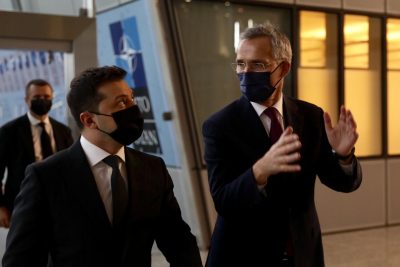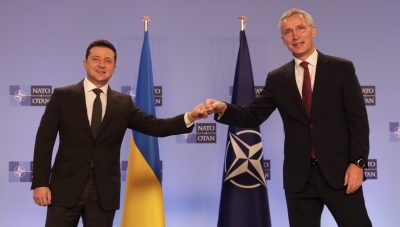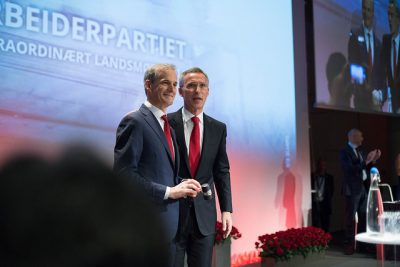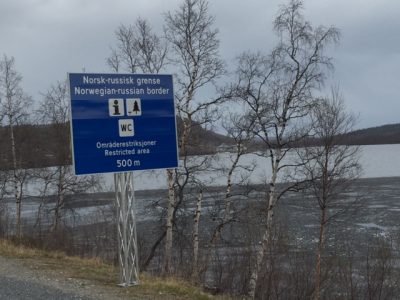Norwegian Prime Minister Jonas Gahr Støre has warned there’s grave danger of armed conflict in Eastern Europe, after Russia has placed more than 100,000 soldiers along its border to Ukraine. As a member of NATO, which declared once again on Thursday that it supports Ukraine’s sovereignty and right to decide over its own territory, Norway stands to be pulled into any conflict and is boosting security at its own border to Russia.

“We have to think through our own preparedness,” Støre told Norwegian Broadcasting (NRK) this week. “Along with our NATO allies and Nordic neighbours we have to be on guard.”
Støre added that there’s “very much a danger that this (Russia’s military build-up) can lead to conflict, that it can be a military conflict, and that there can be acts of war between countries.” Even though armed conflict can still be avoided, he told NRK that “what’s happening now is very disturbing.”
NATO Secretary General Jens Stoltenberg agrees, and met on Thursday with Ukraine’s President Volodymyr Zelenskyy at NATO headquarters in Brussels. He welcomed the hard-pressed Zelenskyy, who is currently being subjected to increasingly severe intimidation by its neighbour to the east.
“We call on Russia to return to diplomacy, to de-escalate and to respect Ukraine’s sovereignty and territorial integrity,” Stoltenberg said at a press conference following the meeting with Zelenskyy. Stoltenberg stressed that Russia’s build-up at the border, aimed at both intimidating and destabilizing Ukraine, “has no justification and undermines security in Europe.”
Stoltenberg stressed that “any further aggression against Ukraine will have severe consequences and would carry a high price.” He noted how NATO allies have seen “a pattern of aggressive acts from the Russian side,” with NATO “showing an ability to respond.”

The NATO boss repeated that the alliance has strengthened its collective defense since Russia shocked Europe in 2014 by controversially annexing Ukraine’s Crimean peninsula, right after hosting the Winter Olympics. Stoltenberg vowed that NATO will do what’s necessary to protect all NATO allies and Ukraine, which is not a NATO member but has received lots of support not only from NATO but also directly from the US, Germany and other NATO members including Norway.
‘Tensions are high’
Stoltenberg also stressed, however, that NATO is ready to speak with Russian leaders. “Dialogue is even more important when tensions are high,” Stoltenberg said. Russia, meanwhile, has already claimed it would be “unacceptable” for Ukraine to become a member of NATO, nor will Russia tolerate any NATO bases or arms placed on Ukrainian soil.
Russian officials handed over demands for guarantees against such at a meeting with their US counterparts in Moscow earlier this week. Stoltenberg countered that no one other than NATO’s 30 members and Ukraine itself can decide whether Ukraine might one day join NATO.

Norwegian Prime Minister Støre earlier served as Norway’s foreign minister under Stoltenberg when the NATO boss was Norway’s prime minister. Støre shares Stoltenberg’s deep concern about the Russian military build-up along the Ukrainian border that started months ago and comes seven years after Russia’s annexation of Crimea. The annexation set off economic sanctions against Russia under which Russian President Vladimir Putin is clearly suffering and wants lifted. Støre thinks tensions between Russia and Europe are now at their highest point since the former Soviet Union started breaking up in 1989.
Russia and Putin, meanwhile, have also been supporting Europe’s last dictator in Belarus, Alexander Lukasjenko, and his own efforts to fend off EU sanctions by sending migrants from the Middle East to the borders of Poland, Lithuania and Latvia. All three of those countries, liberated after the Soviet Union broke up, already are NATO members.
Norway, which shares a border with Russia in the far north, experienced a similar migrant situation during the influx of asylum seekers all over Europe in 2015. Thousands of migrants managed to make their way through Russia, clearly with the help of Russian officials, to the border crossing at Storskog just east of Kirkenes. It was only after former Prime Minister Erna Solberg pushed through new asylum procedures and negotiated with Russia that the migrant stream ended.

Newspaper Aftenposten reported recently that Norway has taken steps to prepare for any new migrant influx. “What’s happened at the borders to Lithuania, Latvia and Poland illustrates a potential vulnerability that’s relevant for (Norway’s border crossing at) Storskog,” Frode Forfang, director of Norway’s immigration directorate UDI (Utlendingsdirektoratet), told Aftenposten. He notes that Storskog is also a border crossing into the EU’s Schengen area, of which Norway is a part through its trade agreement with the EU.
“When other borders into Europe become more difficult to cross (such as when Poland sent thousands of soldiers to defend its border to Belarus), we know that migrants and smugglers will look for new opportunities,” Forfang said. He noted that Norway relies on how Russia controls border traffic from its side, and on traditional friendly ties with Russians in the region.
With Putin unhappy, however, over sanctions and NATO, and Norway attached to both, he may direct another stream of migrants to Storskog. UDI, at least, will be prepared with staffing and a new center in the area that it hopes won’t be filled up.
newsinenglish.no/Nina Berglund

